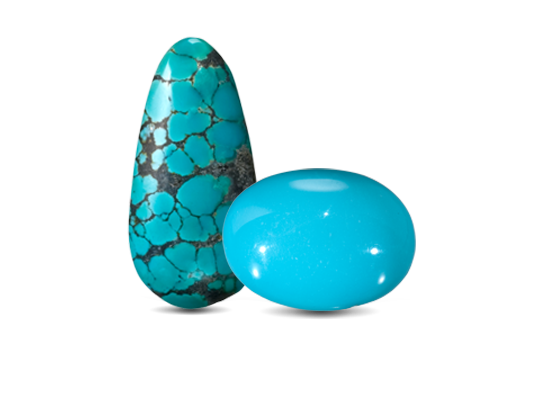
The gem’s name comes from the French expression "pierre tourques", or “Turkish stone.” The name, which originated in the thirteenth century, reflects the fact that the material probably first arrived in Europe from Turkish sources. MEFKAT - Ancient Egyptians called turquoise “mefkat,” which also means “joy” and “delight.” Turquoise is sought after by designers around the world.
Turquoise is found in only a few places on earth: dry and barren regions where acidic, copper-rich groundwater seeps downward and reacts with minerals that contain phosphorus and aluminum. The result of this sedimentary process is a porous, semi-translucent to an opaque compound of hydrated copper and aluminum phosphate. Turquoise is a prime example of an opaque colored stone that can be marketed both as a gem for jewelry and as an ornamental material.
4,000 BC - Turquoise buried in Ancient Egyptian tombs is among the world’s oldest jewelry. Turquoise is one of the world’s most ancient gems. Archeological excavations revealed that the rulers of ancient Egypt adorned themselves with turquoise jewelry, and Chinese artisans were carving it more than 3,000 years ago. Turquoise is the national gem of Tibet and has long been considered a stone that guarantees health, good fortune, and protection from evil. Turquoise is relatively soft, so it’s ideal for carving. Artists in Europe, Asia, the Middle East, and the Americas choose turquoise as a medium for carved jewelry and art objects. It’s often fashioned into talismans with Native American significance, such as bird and animal carvings, called fetishes.
The traditional source for the top color, sometimes described as robin’s-egg blue or sky blue, is the Nishapur district of Iran, the country formerly known as Persia. So, quite often, you’ll hear people in the trade call turquoise of this beautiful color “Persian Blue,” whether or not it was actually mined in Iran. The most prized turquoise color is an even, intense, medium blue. But some consumers prefer a greenish blue, and some contemporary designers actively seek avocado and lime green turquoise. Turquoise ranges from blue to green. Generally pure saturated blue shades are the most valuable.
Turquoise might lack the sparkle and clarity of transparent colored gemstones like ruby, emerald, and sapphire, but its multi-layered history and soul-satisfying color make it a desirable gem.
Natural turquoise is porous and can be damaged by chemicals in cleaning products, perfume, and cosmetics which can a¬ffect its color. It can also absorb skin oil which will darken the color of the material. Put your turquoise jewelry on after applying products to your skin like sunscreen, lotion, makeup or hairspray, and remove before using household cleaning products. Never put turquoise into an ultrasonic or steam cleaner. Cleaning with mild soapy water is best.
Photos Courtesy of GIA